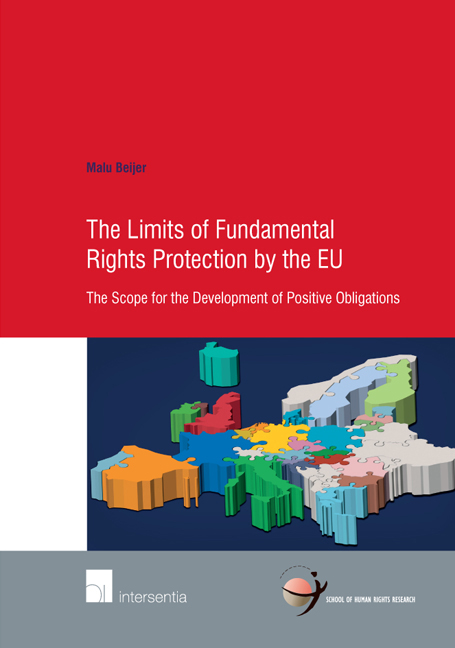 Limits of Fundamental Rights Protection by the EU
Limits of Fundamental Rights Protection by the EU Book contents
- Frontmatter
- About the Author
- Acknowledgements
- Contents
- Abbreviations
- Table of Cases
- Chapter 1 Introduction
- PART I THE CONCEPT OF POSITIVE OBLIGATIONS WITHIN THE CONTEXT OF THE EUROPEAN CONVENTION ON HUMAN RIGHTS
- Chapter 2 The System of Fundamental Rights Protection Under the European Convention on Human Rights
- Chapter 3 The Development of Positive Obligations Under the European Convention on Human Rights
- Chapter 4 A Critical Appraisal of the Development of Positive Obligations Under the European Convention on Human Rights
- Chapter 5 Part I – Conclusions
- PART II THE SCOPE FOR THE DEVELOPMENT OF POSITIVE OBLIGATIONS WITHIN THE CONTEXT OF EU LAW – AN ANALYSIS OF THE SPECIFIC PARAMETERS OF THE EU LEGAL ORDER AND THE EU SYSTEM OF FUNDAMENTAL RIGHTS PROTECTION
- PART III SYNTHESIS
- Bibliography
- Index
- Miscellaneous Endmatter
Chapter 2 - The System of Fundamental Rights Protection Under the European Convention on Human Rights
from PART I - THE CONCEPT OF POSITIVE OBLIGATIONS WITHIN THE CONTEXT OF THE EUROPEAN CONVENTION ON HUMAN RIGHTS
Published online by Cambridge University Press: 27 September 2018
- Frontmatter
- About the Author
- Acknowledgements
- Contents
- Abbreviations
- Table of Cases
- Chapter 1 Introduction
- PART I THE CONCEPT OF POSITIVE OBLIGATIONS WITHIN THE CONTEXT OF THE EUROPEAN CONVENTION ON HUMAN RIGHTS
- Chapter 2 The System of Fundamental Rights Protection Under the European Convention on Human Rights
- Chapter 3 The Development of Positive Obligations Under the European Convention on Human Rights
- Chapter 4 A Critical Appraisal of the Development of Positive Obligations Under the European Convention on Human Rights
- Chapter 5 Part I – Conclusions
- PART II THE SCOPE FOR THE DEVELOPMENT OF POSITIVE OBLIGATIONS WITHIN THE CONTEXT OF EU LAW – AN ANALYSIS OF THE SPECIFIC PARAMETERS OF THE EU LEGAL ORDER AND THE EU SYSTEM OF FUNDAMENTAL RIGHTS PROTECTION
- PART III SYNTHESIS
- Bibliography
- Index
- Miscellaneous Endmatter
Summary
INTRODUCTION
In order to understand the meaning of the recognition of positive obligations under the Convention, it is first important to take into account the particularities of the Convention system. This is because a positive obligation may bear different meanings for each court or body and legal system in which it is applied. The ECtHR, in particular, has derived positive obligations from a catalogue of mainly civil and political rights under the Convention. These rather negatively formulated rights are understood by the ECtHR, principally, as obligations for states to refrain from taking action. How has this system thus allowed for the recognition of positive obligations, which demand an active interference by states?
This chapter provides a further background to the Convention system, which, as such, will be helpful for those looking for some general context of the Convention. It is also of interest for the analysis of the development of positive obligations within this system in the following chapters. Specific topics that are dealt with in this chapter are the background and purpose of the Convention (section 2.2.); its enforcement mechanisms (section 2.3.); the subsidiarity principle (section 2.4.); the role of the ECtHR (section 2.5.); the tools of interpretation of the ECtHR (section 6.); the effects of the Convention in the national legal order (section 2.7.); and the horizontal effect of Convention provisions (section 2.8.). The discussion of these topics is followed by a brief conclusion (section 2.9.).
BACKGROUND AND PURPOSE OF THE EUROPEAN CONVENTION ON HUMAN RIGHTS
The Convention was adopted in 1950. It was draft ed within the Council of Europe, an international organisation that was established to achieve peace and unity in Europe aft er the Second World War. At around the same time the European Coal and Steel Community and the European Atomic Energy Community, and later the European Economic Community, were established. These predecessors of the current EU essentially had the same ideal as the Council of Europe; however, they have mainly sought an economic form of cooperation between states. The Convention was, instead, oriented towards the protection of human rights.
- Type
- Chapter
- Information
- Limits of Fundamental Rights Protection by the EUThe Scope for the Development of Positive Obligations, pp. 19 - 36Publisher: IntersentiaPrint publication year: 2017
